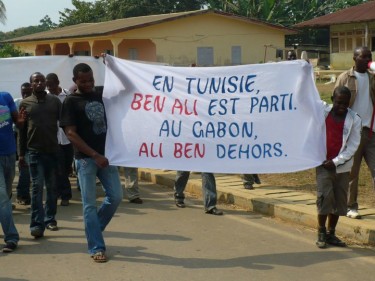by Webster BrooksToday, Sub-Saharan Africa has two military regimes (Madagascar and Niger) and only one monarchy (Swaziland). Thus, the likelihood of a democratic tsunami sweeping over Sub-Saharan Africa is remote. Based on the political mix of Sub-Saharan nations, both the scope and pace of future democratic upsurges will be varied and more deliberate.
Understandably, Sub-Saharan opposition forces are impatient with the status quo and frankly envious of the “Arab Spring” revolts that toppled Egypt’s and Tunisia’s dictators in the space of a few short weeks. But their impatience should be tempered with the understanding that in Egypt and Tunisia, the forces of democracy have yet to win democratic rights and the free elections they demanded; they are negotiating for them. The dictators are gone but the old systems are still intact. The work of re-ordering society on a new democratic foundation will prove far more difficult than dislodging authoritarian rule. It is only in Libya that revolutionary forces are attempting to overturn the old order and seize state power by the force of arms.
Sub-Saharan opposition leaders and academics like Nigerian Eze Ositaalso
observed that North Africa’s risings “enjoy homogeneity in terms of race,
culture and religion—all these make it easier to mobilize as opposed to
sub-Saharan Africa where there is fragmentation.” Osita has a point, but one
that should not be overemphasized. It is true that most North Africa countries are Arabic speaking, practice Islam and share a common culture. These factors have been critical in uniting diverse anti-government coalitions of youth, workers, professionals, Islamists and secular forces. But ultimately reconciling competing economic classes, tribes, religious and linguistic groups are a challenge for political leadership. Muammar Ghadafi ruled Libya for 41 years by force and fear but also by divide-and-rule tactics that pitted the nation’s 140 tribesagainst each other. Libya’s February 17 Revolutionary movement is working hard to win over tribal groups and incorporate them in their decision-making councils. Building broad-based consensus and power-sharing arrangements in the struggle to overturn authoritarian rule is paramount to maintaining political unity and coherence in the new governance structures that emerge. Sub-Sahara’s newest nation, South Sudan, will be an instructive real-time test case of democratic nation-building. Given Sub-Sahara’s difficulties with integrating ethnic groups and tribes into pluralistic governance structures, new democracy movements must revisit Africa’s experience with federalism and granting various forms of regional and cultural autonomy. Nelson Mandela understood this. Robert Mugabe did not. The results speak for themselves.
Finally, the “Arab Spring” revolts brought the issue of Sub-Sahara’s lack of
technology as an essential tool of “people power” revolutions into sharp relief. The upsurges in Gabon and Cameroon were dubbed “the invisible
revolutions”—overshadowed by events in the Middle East that dominated
international satellite television outlets. Moreover, while cell phone use in
most African countries is common, other forms of technology are not. The rate of Internet use in Tunisia is 34 percent, compared to six percent in Gabon and ten percent in Uganda. Indeed, South Africa is the only nation in Sub-Saharan Africa that has an Internet use rate comparable to Western Europe. To be sure Facebook and Twitter revolutions are coming toSub-SaharanAfrica, along with an African equivalent of Al-Jazeera. For Africa’s restive new democracy and revolutionary movements, they can’t come soon enough.**********
The headwinds of the “Arab Spring” democracy risings in Egypt, Morocco and Libya are blowing south across sub-Saharan Africa. Inspired by Tunisia’s January 17 “Jasmine Revolution” that ignited political revolts throughout the Middle East, pockets of protests have erupted in predominantly Black Africa. On February 18, Oumar Bocoum set himself on fire at Senegal’spresidential palace to protest cuts to his army pension, imitating the 26 year-old student whose act of self-immolation led to the toppling of Tunisian dictator Ben Ali. In Cameroon, a February 23 “people power” march challenging the 28-year rule of President Paul Biya was shut down by an unprecedented show of military force in the nation’s capital. Similarly, opposition forces in oil rich Gabon demanding an end to the
Bongo families’ forty-year rule have clashed repeatedly with the military in
several cities since January. And, on February 21 in Zimbabwe, 46 students and activists were arrested for “plotting the overthrow” of longtime President Robert Mugabe after watching videos on CNN of the uprisings in Egypt and Tunisia. These developments have sparked debate among Africa’s political activists regarding the prospects of North Africa’s “people power” revolutions spreading to the Sub-Saharan. The answer according to many Sub-Saharan opposition forces is no, and they are most likely correct.
Unlike most North African and Arab Middle East nations that are ruled by
authoritarian leaders and monarchies, Sub-Saharan Africa has a solid base of functioning democracies. African elections expert Alfred C. Nunley’s website Africanelections.tripodidentifies 19 of Sub-Saharan Africa’s 47 countries as fully functioning democracies and another eight countries as “emerging democracies.” These countries with open political systems and higher performing economies serve as a counterweight to the expansion of authoritarian rule and “restrictive democracies”—states essentially ruled by a single party and leader.
